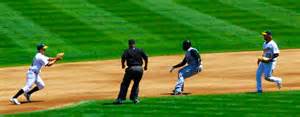Drills - How to Properly Perform RunDowns
Do you remember drills, which became a game called Hot Box when you were a kid, where two fielders would have a runner between them attempting to tag him out before he reached a base safely? The fielders would throw the ball back and forth while the runner would dart back and forth like a hamster, sometimes needing 8 or 10 throws before being put out.

Catcher Holding Ball Out - Pitcher Backing Up Play- Running Back To Base
There are a couple of important points to remember when performing rundowns.
1. Always force the runner to run back to the base he came from.
2. Force the runner to commit so there’s no turning back.
Let’s look at some action which will explain in detail how to perform rundowns.

Drills - Pitcher Running Directly At Runner
No matter how much fun that was, that was then …now is now and rundowns performed like that is totally unacceptable. A run down requiring more than 1 throw, 2 depending on what you count as a rundown throw, was not performed correctly.
Situation: Runner on second is attempting to steal third base, but slips. Because of the slip the third baseman now has received the throw from the catcher and the runner is caught in between second and third.
The third baseman runs as hard as he can towards the runner forcing him to retreat to second base, his original starting point. The third baseman should hold the baseball up and out where the second baseman has a clear view of it.
Never make a throw over the runner’s head, because the ball is hidden from the other player’s view. He won’t even know you threw the ball.
At this point there are two things that could occur for a successful rundown.
1. The third baseman is faster than the base runner and simply runs him down and tags him out.
2. The third baseman forces the runner into an all outright run back to second, then throws to the second baseman. The runner will not be able to stop, reverse field and be able to outrun the second baseman who will tag the runner out.
Let’s review what we’ve done. The runner is caught in between bases. The third baseman runs at the runner as fast as he can. This forces the runner to run as fast as he can back to second base to avoid being tagged out.
The third baseman catches the runner and tags him out, or while running and keeping the ball in clear view for the second baseman, he throws to the second baseman when he decides he can not catch the runner himself.
The runner can’t stop, turn and run away from the second baseman who will be moving towards the runner in the opposite direction. The second baseman tags the runner.

Get Him Running Hard
One Throw … two if you count the throw from the catcher to the third baseman and the runner’s out.
No fuss, no muss … get the out quickly and efficiently. As an addendum to this particular situation, the pitcher should be backing up the third baseman and the shortstop should be backing up second base.
Situation: Runner on third base. When the pitcher toes the rubber and begins his stretch position, the runner takes off for home plate.
The pitcher should immediately step backwards off the rubber which should freeze the runner in his tracks. When this occurs, the pitcher should run straight at the runner as fast as he can.
There are many times the runner will be so confused as to which way to run he won’t be able to move or makes a move at the last moment, which will be far too late to avoid the tag out.
As you are running toward him, should he try to retreat to third base, continue to chase him, preventing him from being able to reverse his field and throw a strike to the third baseman.

Ball Well Displayed
Should he continue to run towards home plate after you have stepped off the rubber, throw home to the catcher. You don’t throw a strike over the plate! At this point the throw is not a pitch, but a throw as if any other fielder was making the throw.
The catcher should have stepped out of the catcher’s box, as if calling a pitch out giving you a target away from the plate and batter.
There you have it…the proper method of performing rundowns. A little practice and you’ll have your players performing this drill like the professionals.
Drills to Youth Baseball Skill Drills

New! Comments
Have your say about what you just read! Leave me a comment in the box below.